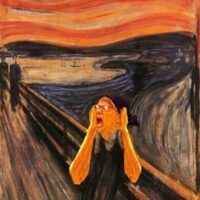
Standard deviation can be defined as the statistical dispersion of a set of data. When the data falls close to the average, or mean, it has a small standard deviation. All normally distributed data has common standard deviation. As stated in the paragraph below, this spread is called, “The empirical rule.”
“In practice, one often assumes that the data are from an approximately normally distributed population. This is frequently justified by the classical central limit theorem, which says that sums of independent, identically-distributed random variables are normally distributed. If that assumption is justified, then about 68% of the values are within 1 standard deviation of the mean, about 95% of the values are within two standard deviations and about 99.7% lie within 3 standard deviations. This is known as the “68-95-99.7 rule”, or “the empirical rule”(Wikipedia, 2006)
I use this curve to describe the population of planet Earth in terms of commonalities such as IQ and tastes. The majority of people fall within one standard deviation of the mean, or 68.2%, 34.1% above and below the average. These are the majority of people watching football, going to church, and having meetings at work.
The first set of people willing to walk outside the norm are those within two standard deviations. Here most of the overachievers and underachievers fall. These include the corporate executives and most “A” and “D” students, above and below 95.4%. Next come the three standard deviation individuals. Geniuses and the mentally challenged fall into this category.
The main reason we are discussing this idea today is to illustrate the fact that the majority of people treat those ABOVE the mean in standard deviation the same as those BELOW the mean. What does this mean in plain terms? That the geniuses are often lumped in with the mentally challenged. Why does this matter to you?
This matters to the bulk of my readers because being different causes them to be treated as BELOW average. When in reality you have a choice. You can choose to be above, or below the mean. In Junior High School at thirteen I moved schools. I moved from the melting pot of Los Angeles Gifted Schools to the sea of mediocrity called
Davis, California. This shocked me to say the least.
Once there I discovered that there was no gifted program and that I had to enter the general population of American public schools at the peak of their cruelty. I was lumped in with the statistical outliers as the only Indian child not part of their cliques. First I did not align, I remained a member of all the groups. Until one day one of the popular kids asked me why I hung around with those other thugs. I told her, “because they never ask me that about you.”
From that day forward I stopped hanging around the beautiful people. A choice presented itself to me. Join the tough guys, or the geeks. I thought that the thugs outcasted themselves while the geeks were outcasted by the popular children. So I stayed with the tough guys. Only later, I realized two things. One, the thugs did not have a accepting standards, they had no standards. Two, both groups were outcasted.
These delineations that I discovered were the natural representation of the bell curve above. Both groups were two standard deviations. Most of my tough guy friends were all in special or remedial classes, while the geeks all met with me in band and mathematics. The choice for all of us outliers is to choose which part of the curve we want to be.
Eventually in life I gravitated to the top of the bell curve rather than the bottom. This significant idea is captured in a quote from Jesus in my book:
107. Jesus said, “The (Father’s) kingdom is like a shepherd who had a hundred sheep. One of them, the largest, went astray. He left the ninety-nine and looked for the one until he found it. After he had toiled, he said to the sheep, ‘I love you more than the ninety-nine.'” (Miller, 1994)
Most people read this to understand that a self-master will go after lost sheep. Although this reading, fits it actually has two meanings just as the standard deviation does. Both the bottom of the bell curve and the top appear lost to the bulk of the herd. People lost at the bottom are generally ignorant and lost, while those at the top are lost while trying to chart a visionary course.
Self-masters exist to serve them both; masters of Bhakti, or devotion and love, and masters of Jnana, or knowledge and truth. The master of devotion goes for the bottom of the bell curve to serve the sick and the afflicted. While the master of knowledge goes to the top to serve the wayward geniuses. Regardless of where you fit, you need to choose how you are going to serve the masses, and hence yourself.
The key to using this idea is to choose where you want to fit in the curve and to fulfill that niche. All roles are needed in a working system, all are appreciated. Some are more easily replaced than others though. A genius can sweep the floor, albeit difficultly, while the janitor can rarely solve multi-variable calculus.
Many people find this last statement offensive and difficult to digest. I mean it neither offensively nor judgmentally. It is a statement of fact only to help one find a place in the wide spectrum of possibilities. Furthermore, the curve itself is a tool to show distributions. I do not dictatorially place anyone other than myself on the curve. Moreover, my personal place on it has changed. So can yours.
Reference:
Robert J. Miller, ed., (1994) The Complete Gospels: Annotated Scholars Version. Polebridge
New York: Press. Retrieved May 9, 2007, from http://www.gnosis.org/naghamm/gosthom.html
Wikipedia, (2007) “Standard Deviation.” Retrieved May 9, 2007, from http://en.wikipedia.org/wiki/Standard_deviation






Leave A Comment